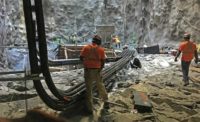When the Michigan Central Station was constructed in 1913, passenger rail reflected Detroit’s booming role in the industrial revolution, with historical records indicating that the structure was the tallest station of its time. Decades later in the 1980s, as the city’s train travel slowed and car ownership became ubiquitous, the station shuttered—but its abandoned remains still loomed as a reminder of the Motor City’s abrupt economic decline.
During its heyday, the station held “over 4,000 daily visitors,” says Richard Hess, principal architect at the Ann Arbor, Mich.-based, architectural design preservation firm Quinn Evans. Now, a $740-million renovation project helmed by Ford Motor Co. aims to bring visitors back to the area by making the Central Station the centerpiece of a 30-acre mobility innovation district.
With Ford in the driver’s seat, the CM at-risk project has been moving at full speed from the moment the automobile manufacturer took ownership of Central Station in 2018, says Hess. Ford approached Quinn Evans to do a structural assessment, and the company brought in Christman-Brinker as contractor and construction manager early in the process.
“When we began working on this together—Quinn Evans and Christman-Brinker company—really nobody had been in the building,” says Hess. “The original character was still intact, but a lot of that has needed to be peeled back and taken apart to repair the structure behind it.”

Restoration involved many historic elements including a tile ceiling.
Photo courtesy of Josh Scott
To put the station on track to open this year, Ford enlisted Evans; Christman Co. and L.S. Brinker in a joint venture as Christman-Brinker to serve as contractor and construction manager; and a team of more than 400 specialty contractors to rehab and restore the structure from the inside out.
“And of course, the fun part now is putting it all back together,” says Hess.
One of the first challenges the restoration project faced was to bid the project out in eight bid packages.
“Originally, we were hoping for three or four bid packages,” explains Ron Staley, senior vice president of the Christman Co.’s southeast Michigan operations and executive director of its historic preservation group. “But because of design and the desire to push this out as fast as we could, it was really a four-year design and construction project for something this huge.”
The core AEC team spent one year together meticulously planning how the project could be executed and expedited within Ford’s given time frame, Staley says.
Unveiled during a community meeting in Detroit on Nov. 17, 2020, Ford’s multiyear development plan for a mobility district in the city includes the rehab of the Central Station, the transformation of its adjacent Book Depository building into a learning center, the construction of a yet-to-be named new development and the renovation of the nearby Factory, a building that currently houses Ford’s autonomous vehicle team. Mobility district collaborators include Google, a handful of innovation and other tech start-ups, and the state’s Office of Future Mobility and Electrification.
Located in Detroit’s Corktown neighborhood, the tech hub will also be the site of the first wireless inductive charging system for electric vehicles in the U.S., designed by Israeli start-up Electreon.
“As we aim to lead the future of mobility and electrification by boosting electric vehicle production and lowering consumer costs, a wireless in-road charging system is the next piece to the puzzle for sustainability,” said Michigan Gov. Gretchen Whitmer in a statement announcing the pilot project.

Constructed in 1913, Michigan Central Station will now be part of a new mobility district.
Photo courtesy of Josh Scott
Turning Back Time
The last passenger train left the Michigan Central Station depot in 1988. And though the building has been empty for more than 30 years, contractors say the wear and tear from Michigan winters had done plenty of damage.
“For the first year, it was really cleaning it out, drying it out and stabilizing it structurally,” Hess says of the effort, which included pumping out 2.5 million gallons of water that had accumulated in the basement of the building. The basement sits a few inches below the nearby Detroit River, making it the lowest point in the area and a pooling point for water runoff. There was no roof on the back concourse and water damage had caused the building to rot from its core to its coverings.
“We’ve done a lot of design to come up with ways to capture that moisture. It has been a problem in this building since the early stages.”
—Richard Hess Principal Architect, Quinn Evans
“We’ve done a lot of design to come up with ways to capture that moisture. It has been a problem in this building since its early stages,” says Hess, explaining that the team went through an “entire research process” to piece together a complete set of drawings for the building to understand the original design and construction.
In the state archives of Michigan, the team found old drawings and blueprints for the station, the adjacent track platforms and ancillary structures around the station. They also found masonry paperwork with clues into the origins of the building’s stone and light fixture details.
“Those were critical. [From] the shop drawings for the actual light fixtures, we can see the design concepts but also how they fabricated the light fixtures [more than 100] years ago,” says Hess. “That was a real treasure load of information and intel that we did not have before, and Ford has been really good at wanting to replicate as many historic details as the team can document.”

The interior features Guastavino tile, a unique clay tile system.
Photo courtesy of Christman Co.
Keeping the Team on Track
The inside space as the Michigan Central Station, including the train terminal and office space, is about 650,000 sq ft. The area open to the public will have three main corridors. In the office tower, there are 13 floors, but the building actually has around 18 levels, including the main level, a storage floor, a pipe chase floor, a basement and a subbasement.
“This was all area that was originally unexcavated by the drawings,” says Jeff White, project superintendent at Christman, referring to the station’s extra levels. “So getting down there, we basically found out that we had a 100,000-sq-ft basement that needed to be tackled in addition to everything above.”
While teams worked inside to stabilize the building, the outside was broken down into quadrants so contractors could safely work vertically installing windows and stone elements and work horizontally restoring roofing and cornices without overlap. White likes to call it as a “Rubik’s Cube” approach, getting all the colors to line up at the right time. Teams in one quadrant must be finished by a certain date so they can hop over and open another quadrant for other workers.

The steel contractor remade cast iron-framed windows on the ground floor.
Photo courtesy of Christman Co.
“We have the exterior area, the tower area, the ground level area and the basement area. And each of those has a superintendent and a safety and project engineer managing that area,” says White. “They work from the bottom up. Replacing steel, working on the cornice, the decking and the structure, replacing brick, tech caulking, working on the pediments of the building [and directing] steel replacement.”
Staley says that Christman-Brinker had “never seen a single building with this many components in it,” including its detailed historical architectural elements such the Guastavino tile ceiling in the station’s former waiting room.
“The Guastavino tile on the inside, as far as we know, is one of the largest projects in the Midwest to have that unique clay tile system in it,” explains Staley. The cost of restoring the tile alone was upward of $4 million, including sound vibration monitors to track and sense how the restored tile performs under sound waves.
“To have a $4-million restoration project just for ceiling tiles was unheard of.”
—Ron Staley, Senior Vice President, Christman Co.
Allen Architectural Metals, a local minority-owned steel contractor, remade the cast iron-framed windows seen on the ground level. Local custom architectural sheet metal specialist Cass Sheet Metal installed a new copper roof and finishings on the station’s central obelisk. Other elements, such as the station’s exterior columns, were first hand carved, taking 440 hours, then laser scanned for easier and faster replication using computer numerical control (CNC) software. Four different mason restoration firms were needed to work on different parts of the station’s exterior stone.
“To have a $4-million restoration project just for a ceiling of tile was unheard of,” says Staley, explaining that planning down to how those restorative details would be completed was key to keeping the construction schedule.
“As a construction manager, we’re the orchestra leader, and we have some of the best musicians in the world out here. We have some of the best trade contractors,” says Staley. “It takes an orchestra leader to bring those fine musicians together to make great music.”
When the station is completed, and the mobility start-ups move in, it will be the first time in 100 years that the structure will be fully utilized, says White.
“Not once, not even when it was originally constructed, has the building fully been occupied. The top floors were never finished out. They would always remain vacant. Most of the tower ended up being storage space to support to the train station,” he explains. “It was always one thing to finance the restoration and the rehabilitation of this building but it’s another to figure out how do you use the building moving forward to make it financially sustainable for the next generation. That’s a challenge, and Ford has certainly tackled it.”





---Urban-Mining-Industries-Pozzotive_ENRready.jpg?height=200&t=1663257031&width=200)
Post a comment to this article
Report Abusive Comment